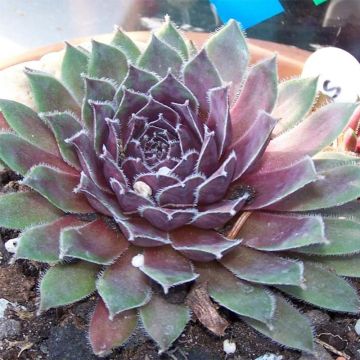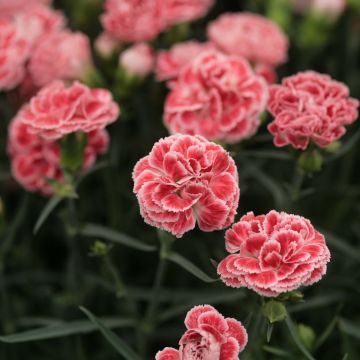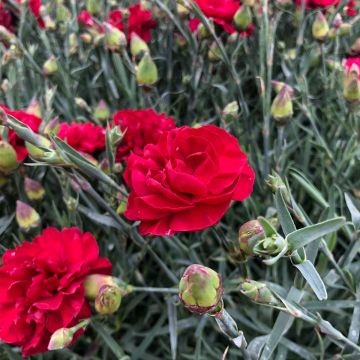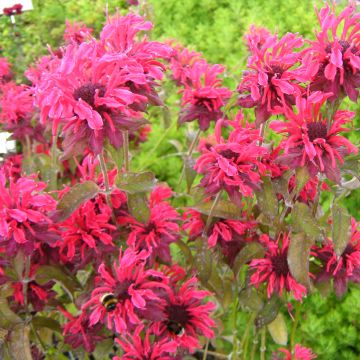

Sempervivum Granat


Sempervivum Granat
Sempervivum Granat
Sempervivum Granat
Houseleek, Hen and Chicks
This item cannot be shipped to the selected country
Delivery charge from €5.90
More information
Schedule delivery date,
and select date in basket
This plant carries a 12 months recovery warranty
More information
We guarantee the quality of our plants for a full growing cycle, and will replace at our expense any plant that fails to recover under normal climatic and planting conditions.
From €5.90 for pickup delivery and €6.90 for home delivery
Express home delivery from €8.90.
Does this plant fit my garden?
Set up your Plantfit profile →
Description
Sempervivum 'Granat' is one of the most beautifully coloured houseleek varieties, whose decorative tone lasts throughout the year. Its mature rosettes take on a predominantly pink-purple hue, even in winter, forming a pleasant colour combination with the almond-green periphery. In spring, they are surrounded by young and pretty rosettes of shiny purple-garnet leaves. Its summer flowering in pink harmonises with the vegetation. Clinging with all its might to life, even when abandoned on a pile of stones, the houseleek is a modest but endearing plant that always manages to win the gardener's heart.
The houseleek is a perennial succulent plant of the Crassulaceae family. All sempervivum species grow spontaneously in rocky lawns, on rocks and scree, in open and sunny situations, mainly in mountainous areas. Their vegetation persists throughout the year, even in winter.
The hybrid variety 'Granat' has thick and long roots that penetrate deeply into rock crevices, ensuring a good grip on the walls while drawing water from deep sources. The plant is particularly prolific. It quickly forms beautiful colonies of rosettes of different sizes, juxtaposed, reaching 6cm (2in) in diameter at maturity, and not exceeding 8cm (3in) in height. Over time, it uses its stoloniferous stems to form a mound or a dense carpet spreading over 30 to 40cm (12 to 16in) on the ground, perfectly fitting the terrain. Slightly resembling a sea urchin, each rosette is composed of numerous pointed, fleshy, upright leaves, tightly packed together and without petioles. Their colour is a clever blend of pink-purple, garnet, tender green, and even soft yellow-green. It remains consistently uniform throughout the year. The flowering appears sporadically on rosettes aged 2 or 3 years, which will then disappear, having ensured the plant's perpetuity through the production of numerous small rosettes on the periphery. The 12cm (5in) tall flower stalks develop from June to August, formed by thick stems that carry 1 to 5 star-shaped flowers with 8 to 10 pink-purple petals.
Sempervivum 'Granat', like all houseleeks, is a boon for alpine gardens, as well as in all rocky places where the soil is shallow. It thrives where few species survive, colonising abandoned spaces. If your soil is poor, rather dry, stony, rocky, or even slightly chalky, you can still enjoy this hardy perennial (which can withstand temperatures below -15°C (5°F)). It requires no maintenance and promises to liven up any pile of stones, a low wall, or even a green roof. Houseleeks are unusual and easy-to-care-for succulent plants. Their flowers and foliage in various shades create a desire to collect them, propagate them, and create astonishing displays in the most inhospitable places. They are magnificent in pot arrangements, especially in low terrine-like containers, and irreplaceable in borders, troughs, or rock gardens, alongside wall bellflowers or Lewisia cotyledon. Consider choosing companions with staggered bloom times (sedums, thymes) and colourful foliage (bergenia, Euphorbia myrsinites) to create a variegated and joyful rock garden.
Report an error about the product description
Sempervivum Granat in pictures






Flowering
Foliage
Plant habit
Botanical data
Sempervivum
Granat
Crassulaceae
Houseleek, Hen and Chicks
Cultivar or hybrid
Other Sempervivum - Houseleek
Planting and care
Sempervivum 'Granat' enjoys sunny exposures and perfectly drained, moist to very dry and poor, sandy or gravelly soils. Wet soils in winter harm its hardiness. You can plant it in the ground or in a container in spring or autumn, adding gravel or coarse sand to the planting substrate. Conversely, if you place it in a rockery or on a wall, just give it a little compost to help it to establish. Afterwards, it will manage on its own. You can also grow it in a pot, watering it occasionally from spring to summer. Dry soil in winter is appreciated.
If you wish to multiply it, simply cut a few young rosettes and replant them elsewhere, burying the roots barely. Take care of it by ensuring it is not overwhelmed by taller plants, that it is not covered in dead leaves or plant debris, and by possibly removing faded small inflorescences.
Planting period
Intended location
Care
-
, onOrder confirmed
Reply from on Promesse de fleurs
Summer flowering perennials
Haven't found what you were looking for?
Hardiness is the lowest winter temperature a plant can endure without suffering serious damage or even dying. However, hardiness is affected by location (a sheltered area, such as a patio), protection (winter cover) and soil type (hardiness is improved by well-drained soil).

Photo Sharing Terms & Conditions
In order to encourage gardeners to interact and share their experiences, Promesse de fleurs offers various media enabling content to be uploaded onto its Site - in particular via the ‘Photo sharing’ module.
The User agrees to refrain from:
- Posting any content that is illegal, prejudicial, insulting, racist, inciteful to hatred, revisionist, contrary to public decency, that infringes on privacy or on the privacy rights of third parties, in particular the publicity rights of persons and goods, intellectual property rights, or the right to privacy.
- Submitting content on behalf of a third party;
- Impersonate the identity of a third party and/or publish any personal information about a third party;
In general, the User undertakes to refrain from any unethical behaviour.
All Content (in particular text, comments, files, images, photos, videos, creative works, etc.), which may be subject to property or intellectual property rights, image or other private rights, shall remain the property of the User, subject to the limited rights granted by the terms of the licence granted by Promesse de fleurs as stated below. Users are at liberty to publish or not to publish such Content on the Site, notably via the ‘Photo Sharing’ facility, and accept that this Content shall be made public and freely accessible, notably on the Internet.
Users further acknowledge, undertake to have ,and guarantee that they hold all necessary rights and permissions to publish such material on the Site, in particular with regard to the legislation in force pertaining to any privacy, property, intellectual property, image, or contractual rights, or rights of any other nature. By publishing such Content on the Site, Users acknowledge accepting full liability as publishers of the Content within the meaning of the law, and grant Promesse de fleurs, free of charge, an inclusive, worldwide licence for the said Content for the entire duration of its publication, including all reproduction, representation, up/downloading, displaying, performing, transmission, and storage rights.
Users also grant permission for their name to be linked to the Content and accept that this link may not always be made available.
By engaging in posting material, Users consent to their Content becoming automatically accessible on the Internet, in particular on other sites and/or blogs and/or web pages of the Promesse de fleurs site, including in particular social pages and the Promesse de fleurs catalogue.
Users may secure the removal of entrusted content free of charge by issuing a simple request via our contact form.
The flowering period indicated on our website applies to countries and regions located in USDA zone 8 (France, the United Kingdom, Ireland, the Netherlands, etc.)
It will vary according to where you live:
- In zones 9 to 10 (Italy, Spain, Greece, etc.), flowering will occur about 2 to 4 weeks earlier.
- In zones 6 to 7 (Germany, Poland, Slovenia, and lower mountainous regions), flowering will be delayed by 2 to 3 weeks.
- In zone 5 (Central Europe, Scandinavia), blooming will be delayed by 3 to 5 weeks.
In temperate climates, pruning of spring-flowering shrubs (forsythia, spireas, etc.) should be done just after flowering.
Pruning of summer-flowering shrubs (Indian Lilac, Perovskia, etc.) can be done in winter or spring.
In cold regions as well as with frost-sensitive plants, avoid pruning too early when severe frosts may still occur.
The planting period indicated on our website applies to countries and regions located in USDA zone 8 (France, United Kingdom, Ireland, Netherlands).
It will vary according to where you live:
- In Mediterranean zones (Marseille, Madrid, Milan, etc.), autumn and winter are the best planting periods.
- In continental zones (Strasbourg, Munich, Vienna, etc.), delay planting by 2 to 3 weeks in spring and bring it forward by 2 to 4 weeks in autumn.
- In mountainous regions (the Alps, Pyrenees, Carpathians, etc.), it is best to plant in late spring (May-June) or late summer (August-September).
The harvesting period indicated on our website applies to countries and regions in USDA zone 8 (France, England, Ireland, the Netherlands).
In colder areas (Scandinavia, Poland, Austria...) fruit and vegetable harvests are likely to be delayed by 3-4 weeks.
In warmer areas (Italy, Spain, Greece, etc.), harvesting will probably take place earlier, depending on weather conditions.
The sowing periods indicated on our website apply to countries and regions within USDA Zone 8 (France, UK, Ireland, Netherlands).
In colder areas (Scandinavia, Poland, Austria...), delay any outdoor sowing by 3-4 weeks, or sow under glass.
In warmer climes (Italy, Spain, Greece, etc.), bring outdoor sowing forward by a few weeks.
























































